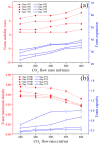Dynamic Foam Characteristics during Cultivation of Arthrospira platensis
- PMID: 35735500
- PMCID: PMC9220301
- DOI: 10.3390/bioengineering9060257
Dynamic Foam Characteristics during Cultivation of Arthrospira platensis
Abstract
This study is aimed at understanding the serious foaming problems during microalgal cultivation in industrial raceway ponds by studying the dynamic foam properties in Arthrospira platensis cultivation. A. platensis was cultivated in a 4 L bowl bioreactor for 4 days, during which the foam height above the algal solution increased from 0 to 30 mm with a bubble diameter of 1.8 mm, and biomass yield reached 1.5 g/L. The algal solution surface tension decreased from 55 to 45 mN/m, which favored the adsorption of microalgae on the bubble to generate more stable foams. This resulted in increased foam stability (FS) from 1 to 10 s, foam capacity (FC) from 0.3 to 1.2, foam expansion (FE) from 15 to 43, and foam maximum density (FMD) from 0.02 to 0.07. These results show a decrease in CO2 flow rate and operation temperature when using the Foamscan instrument, which minimized the foaming phenomenon in algal solutions to a significantly lower and acceptable level.
Keywords: carbon dioxide; flow rate; foam; photobioreactor; stability; temperature.
Conflict of interest statement
The authors declare no conflict of interest. The funders had no role in the design of the study; in the collection, analyses, or interpretation of data; in the writing of the manuscript, or in the decision to publish the results.
Figures








Similar articles
-
Conversion of NaHCO3 to Na2 CO3 with a growth of Arthrospira platensis cells in 660 m2 raceway ponds with a CO2 bicarbonation absorber.Microb Biotechnol. 2020 Mar;13(2):470-478. doi: 10.1111/1751-7915.13497. Epub 2019 Oct 23. Microb Biotechnol. 2020. PMID: 31646765 Free PMC article.
-
Red and blue luminescent solar concentrators for increasing Arthrospira platensis biomass and phycocyanin productivity in outdoor raceway ponds.Bioresour Technol. 2019 Nov;291:121801. doi: 10.1016/j.biortech.2019.121801. Epub 2019 Jul 13. Bioresour Technol. 2019. PMID: 31326685
-
A novel porous nickel-foam filled CO2 absorptive photobioreactor system to promote CO2 conversion by microalgal biomass.Sci Total Environ. 2020 Apr 15;713:136593. doi: 10.1016/j.scitotenv.2020.136593. Epub 2020 Jan 16. Sci Total Environ. 2020. PMID: 31955094
-
A novel magnet-driven rotary mixing aerator for carbon dioxide fixation and microalgae cultivation: Focusing on bubble behavior and cultivation performance.J Biotechnol. 2022 Jun 20;352:26-35. doi: 10.1016/j.jbiotec.2022.05.007. Epub 2022 May 21. J Biotechnol. 2022. PMID: 35605791 Review.
-
Current applications of foams formed from mixed surfactant-polymer solutions.Adv Colloid Interface Sci. 2015 Aug;222:670-7. doi: 10.1016/j.cis.2014.10.001. Epub 2014 Oct 7. Adv Colloid Interface Sci. 2015. PMID: 25455806 Review.
References
-
- Zhao B., Su Y., Zhang Y., Cui G. Carbon Dioxide Fi Xation and Biomass Production from Combustion Fl Ue Gas Using Energy Microalgae. Energy. 2015;89:347–357. doi: 10.1016/j.energy.2015.05.123. - DOI
-
- Ganesh Saratale R., Kumar G., Banu R., Xia A., Periyasamy S., Dattatraya Saratale G. A Critical Review on Anaerobic Digestion of Microalgae and Macroalgae and Co-Digestion of Biomass for Enhanced Methane Generation. Bioresour. Technol. 2018;262:319–332. doi: 10.1016/j.biortech.2018.03.030. - DOI - PubMed
-
- Reen S., Chyuan H., Wayne K., Loke P., Phang S., Chuan T., Nagarajan D., Lee D. Sustainable Approaches for Algae Utilisation in Bioenergy Production. Renew. Energy. 2017;129:838–852. doi: 10.1016/j.renene.2017.04.001. - DOI
-
- Razzak S.A., Hossain M.M., Lucky R.A., Bassi A.S., Lasa H. De Integrated CO 2 Capture, Wastewater Treatment and Biofuel Production by Microalgae Culturing—A Review. Renew. Sustain. Energy Rev. 2013;27:622–653. doi: 10.1016/j.rser.2013.05.063. - DOI
Grants and funding
LinkOut - more resources
Full Text Sources
Other Literature Sources

